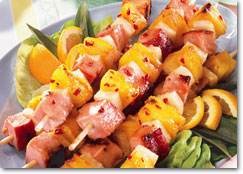 Jicama is more intimate to the Mexican cookery than to the Thai or Vietnamese kitchen. Jicama is also known as sengkwang, “yacon”, yam bean, Mexican potato or Mexican turnip. Jicama is the traditional plant of Mexico and comes in the category of a tuber. The Jicama plant grows as a vine that can reach a height of 4-5m. Jicama is grown only for its taproot as rest of the part of the plant is poisonous. The root’s surface is yellow and papery, while the flesh of the root is creamy white and brittle like potato.
Jicama is more intimate to the Mexican cookery than to the Thai or Vietnamese kitchen. Jicama is also known as sengkwang, “yacon”, yam bean, Mexican potato or Mexican turnip. Jicama is the traditional plant of Mexico and comes in the category of a tuber. The Jicama plant grows as a vine that can reach a height of 4-5m. Jicama is grown only for its taproot as rest of the part of the plant is poisonous. The root’s surface is yellow and papery, while the flesh of the root is creamy white and brittle like potato.
This rare root is starchy and sweet. Only fresh tubers, free from bruises and cracks should be chosen for cooking and it can be stored for a longer period at 12 °C to 16 °C, if you store it in a refrigerator the root will perish as it is sensitive to colder climates. While cooking the upper peel should be removed and washed properly before chopping or shredding. The flavor of Jicama is like water chestnuts.
In different places it is prepared in different ways. In Mexico it is marinated with Mexican lime juice and is seasoned with chili powder. In California, Jicama is added raw to salads or sliced like carrots. This is also chopped to mix with stir fries, sautes and is shredded to mix with prawns, beans, eggs, sausages, carrots and lettuce to serve as a stuffing for spring rolls.
This wonderful vegetable stays crisp after frying and it never softens up even when added to sauces. Jicama is a wonderful treat for the diabetics as the sweet flavor comes from oligofructose inulin, which is not broken down by the human body. Jicama consists of 90 percent water and traces of proteins and lipids. There are lots of ways in which Jicama can be cooked, all that you need is a sharp vegetable knife to cut it into pieces.



